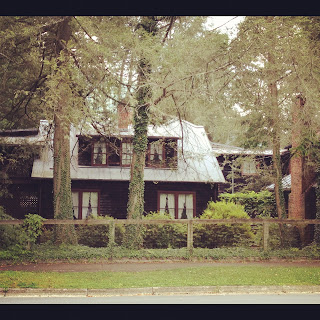John Fox, Jr. is one of the most famous residents - past or present - of Big Stone Gap, Virginia. One of his best-known works was The Little Shepherd of Kingdom Come, which was published in 1903.
This gorgeous edition was illustrated by the illustrious (ha ha!) N. C. Wyeth in 1931. Later, in 1961, a movie by the same name was released. His other famous work was Trail of the Lonesome Pine, written in 1908. This novel was also made into a movie - THREE TIMES! The most recent version, released in 1939, starred Henry Fonda.
The Trail of the Lonesome Pine was also turned into an outdoor drama in 1964 and has been running ever since. Performances take place Thursday, Friday and Saturday evenings from the end of June through August each year at the Trail of the Lonesome Pine Amphitheatre/June Tolliver Playhouse in Big Stone Gap.
 |
| The theater seats between 300-400 people. |
When I was there, the screen door into the house was tantalizingly open, but I fought my urge to sneak inside and take a few more pictures. Sadly, this means that while all of my pictures were snapped legally, they only feature the outside of the property.
The home is on the National Register of Historic Places, and is a source of pride among the residents of Big Stone Gap.
Contemporary critics have taken issue with Fox's now-outdated portrayal of the mountain people he chronicled, including his presentation of women as subservient and his contribution to the "mountaineer" stereotype of Appalachian residents. He is regarded as a noted practitioner of the local-color genre, however, which was a dominant mode of American fiction writing after the Civil War, and he is mentioned alongside other local-color writers such as Kate Chopin, Harriet Beecher Stowe, and Thomas Nelson Page. If Fox's stories are now sometimes seen as sentimental toward his Appalachian characters and setting, the same is true of the local-color genre in general and southern regionalism literature in particular.In short, critics of Fox believe that he did a disservice to Southern Appalachia by helping to create negative stereotypes of its people and culture - stereotypes that would only grow stronger and more prolific as time passed and as ever-increasing numbers of authors jumped on the local-color bandwagon.
I happen to be a big fan of local-color novels - I love the hope and simplicity that they strive to capture. They are stories about characters who have dreams and goals, and good triumphs over evil. In short, they are very different than popular fiction today. Yes, they may be sentimental, and yes, even sometimes silly, but they are more than that - they are good and wholesome, and in my opinion, well worth reading. And, one last thing - I do not believe that readers are so simple as to base their entire perception and understanding of a region and people solely on what they read in a novel. I think the vast majority of readers are much more intelligent than that.
So, if you haven't had the pleasure of reading one of John Fox, Jr.'s books, I suggest you do - I certainly plan to. Or, if you should happen to find yourself in Big Stone Gap during the summer, remember to head down to the June Tolliver Playhouse where you can see a little piece of history being acted out right before your eyes.
Happy exploring!










No comments:
Post a Comment